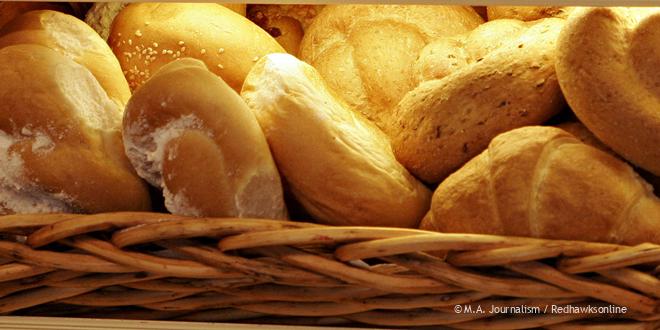Bread, pasta, cake, cookies, are just a few foods gluten free students cannot eat.
Food intolerances affect approximately 15 million Americans. Ranging from gluten to dairy to sugar to meat to nuts, adjustments and special precautions must be made to accommodate to these intolerances. At Minnehaha, gluten intolerances are the most common of these situations. Struggles arise when students bring food for a class and advisory and gluten intolerant students cannot eat it. “Sometimes people bring pizza and it smells so good,” said senior Anna Anderson, who is gluten free,” and I’m like ‘I just want pizza.'”
“If you let [Chef Jonathan] know in advance, he will give you a non-gluten version of the meal he’s making,” said Upper School nurse Heidi Streed, “He really goes out of his way to help out the students [with special dietary needs].” Whether they provides gluten free pasta or bread, the kitchen staff makes sure students have what they need to eat. Upper school kitchen staff member Laura Dubois said there are currently three students who have asked the school for accommodations.
Minnesota public schools are required to accommodate to students’ needs based on Section 504 of the Rehabilitation Act of 1973, the Americans with Disabilities Act (ADA), and the Minnesota HumanRightsAct(MHRA).While a food allergy or intolerance is not technically considered a disability, they are covered under these acts. The definition of disability was expanded to include “a condition that substantially limits a major life activity during an episode or when the condition is not in remission,” according to the Minnesota School Board Association. The most common issues with these laws connect to nut allergies. Many schools must have “nut-free zones” or ban nuts or certain foods, depending on the severity of the allergy. Currently at Minnehaha’s Upper School, there are no students with such an extreme allergy.
Streed has not experienced these extreme situations in a school setting, but she did in a Sunday school class she was teaching,
“There was a student that if he would touch a table that had peanut butter on it at any point in time, he would have an anaphylactic shock,” she said. Situations like these tend to be more prominent in elementary schools where students are younger are are therefore less aware of their surroundings and circumstances. However, high school students can have reactions as severe as this. At Minnehaha’s South Campus, nuts are not used or served, but they are allowed at the North Campus. If high school students have nut allergies, they generally avoid buying school lunches and make sure those around them are aware of their allergy.
Gluten intolerances in particular have been on the rise. Individuals with celiac disease cannot eat gluten due to medical reasons. But celiac disease is not the cause of this upward trend. Experts constantly debate the reasoning behind the increase.
One theory is that wheat is a relatively new addition to the human diet. It has only been consumed for about 11,000 years. Some researchers argue that humans are still adapting to wheat and products like it. However, there is opposition to the theory.
“If eating wheat was so bad for us, it’s hard to imagine that populations that ate it would have tolerated it for 10,000 years,” Sarah A. Tishkoff, a geneticist at the University of Pennsylvania who studies lactase persistence, told the New York Times. Another argument is the fact that humans have adapted to animal milk, so why not wheat?
While scientists, geneticists and dieticians struggle to crack to code, many Americans are shifting their diets to limit or eliminate wheat, even ifthey have not been diagnosed with a gluten intolerance.
The rising health trend has not only dragged many Americans down the road, but also food and beverage companies. Displaying the “gluten free” label on food packaging can enhance the look of the product to the point of selling gluten free water. Clara Gluten Free Water is a company based in Toronto. They claim “You can never be too sure.”
While some believe the phenomenon has been blown out of proportion, the National Foundation for Celiac Awareness argue that gluten sensitivities are more common than most Americans realize.
They estimated 18 million Americans have gluten sensitivities. This differs from Celiac disease and food intolerances in that it cannot be medically tested but is based on how the patient feels when eating or not eating gluten.
While gluten intolerances and nut allergies can throw a curveball into students’ lives, the school and changing environment make accommodations easier.

